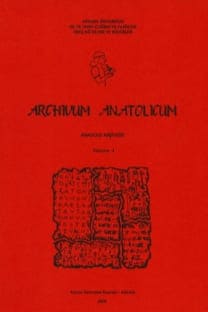Kuzey Lykia’dan Yeni Bir Yapı Yazıtı
Elmalı Müzesi, M.S. 3. yüzyıl, yapı yazıtı, Hellence isimler, epikorik isimler, Kuzey Lykia
A New Building Inscription from Northern Lycia
Northern Lycia, Elmalı Museum, 3rd century AD, building inscription, Greek personal names, epichoric names,
___
- Bresson, Alain. “Les Cariens ou la mauvaise conscience du barbare”, ed. G. Urso, Tra Oriente e occidente. Indigeni, Greci e Romani Asia Minore. Atti del convegno internazionale Cividale del Friuli, 28–30 Settembre 2006. 209–228. Pisa: ETS, 2007.
- Catling, Richard W. V. – Kanavou Nikoletta. “The Gravestone of Meniketes Son of Menestheus: IPrusa 1028 and 1054”, Zeitschrift für Papyrologie und Epigraphik 163 (2007): 103–117.
- Gindin, Leonid A. Troja, Thrakien und die Völker Altkleinasiens. Versuch einer historisch-philologischen Untersuchung. Innsbruck: Institut für Sprachwissenschaft der Universität Innsbruck, 1999.
- Hall, Alan S. – Coulton, John J. “A Hellenistic Allotment List from Balboura in the Kibyratis”, Chiron 20 (1990): 109–158.
- Hellmann, Marie-Christine. “Les signatures d'architectes en langue grecque: Essai de mise au point”, Zeitschrift für Papyrologie und Epigraphik 104 (1994): 151–178.
- Heubeck, Alfred. Lydiaka. Untersuchungen zu Schrift, Sprache und Götternamen der Lyder. Erlangen: Universitätsbund Erlangen, 1959.
- Houwink ten Cate, Philo Hendrik Jan. The Luwian Population Groups of Lycia and Cilicia Aspera during the Hellenistic Period. Leiden: Brill, 1965.
- Hutter, Manfred. “Aspects of Luwian Religion”, ed. H. C. Melchert, The Luwians. 211–280. Leiden/Boston: Brill, 2003.
- İplikçioğlu, Bülent. “Epigraphische Mitteilungen aus Antalya X: Epigraphischer Teil”, Epigraphica Anatolica 35 (2003): 153–156.
- Laroche, Emmanuel. “Divinités lunaires d'Anatolie”, Revue de l'histoire des religions 148/1 (1955): 1–24.
- Le Roy, Christian. “Pisidiens en Lycie et Lyciens en Pisidie”, ed. C. Işık, Studien zur Religion und Kultur Kleinasiens und des ägäischen Bereiches. Festschrift für Baki Öğün zum 75. Geburtstag. 255–266. Bonn: Habelt, 2000 (Asia Minor Studien 39).
- Lebrun, René. “Problèmes de religion anatolienne”, Hethitica 8 (1987): 241–262.
- Naour, Christian. Tyriaion en Cabalide: Épigraphie et géographie historique. Zutphen: Terra Publishing Co., 1980.
- Neumann, Günter. “Namen und Epiklesen lykischer Götter”, eds. E. Masson – C. Brixhe, Florilegium Anatolicum. Mélanges offerts à E. Laroche. 259–271. Paris: E. de Boccard, 1979.
- Neumann, Günter – Tischler, Johann. Glossar des Lykischen. Wiesbaden: Harrassowitz, 2007.
- Orlandos, Anastasios K. – Travlos, Ioannis N. Λεξικόν αρχαίων αρχιτεκτονικών όρων. Athens: Η εν Αθήναις Αρχαιολογική Εταιρεία, 1986.
- Robert, Louis. Noms indigènes dans l’Asie-Mineure gréco-romaine. Paris: A. Maisonneuve, 1963.
- Robert, Louis. “Amulettes grecques”, Journal des savants (1981): 3–44.
- Schuler, Christof. “Griechische Personennamen in Lykien. Einige Fallstudien”, eds. R. W. V. Catling – F. Marchand, Onomatologos. Studies in Greek Personal Names presented to Elaine Matthews. 552–566. Oxford: Oxbow Books, 2010.
- Hdt. (Herodotos) Herodotus, with an English Translation by A. D. Godly, 4 vols, Cambridge MA: Harvard University Press/London: Heinemann 1920–1925.
- IG Inscriptiones Graecae
- IK Die Inschriften griechischer Städte aus Kleinasien
- LGPN V/B A Lexicon of Greek Personal Names, Volume V.B, Coastal Asia Minor: Caria to Cilicia, eds. J.-S. Balzat – R. W. V. Catling – É. Chiricat – F. Marchand. Oxford: Clarendon Press, 2013.
- LGPN V/C A Lexicon of Greek Personal Names, Volume V.C, Inland Asia Minor, eds. J.-S. Balzat – R. W. V. Catling – É. Chiricat – T. Corsten. Oxford: Clarendon Press, 2018. LSJ Liddell, Henry George – Scott, Robert. A Greek-English Lexicon. Oxford: Clarendon Press, 1940.
- Pape Pape, Wilhelm. Wörterbuch der griechischen Eigennamen. Braunschweig: F. Vieweg, 1863–1870.
- Polyain. (Polyainos) Polyaenus, Strategemata, eds. E. Woelfflin – J. Melber, Leipzig: Teubner, 1887.
- SEG Supplementum Epigraphicum Graecum
- Zgusta Zgusta, Ladislav. Kleinasiatische Personennamen. Prague: Tschechoslowakischen Akademie der Wissenschaften, 1964.
- ISSN: 1300-6355
- Yayın Aralığı: Yılda 2 Sayı
- Başlangıç: 1995
- Yayıncı: Ankara Üniversitesi
Kahramanmaraş’tan Aramca Bir Kil Etiket
Eski Mezopotamya Kültüründe Tılsım İnanışı ve Bazı Tılsımlı Objeler
Hititçe Metinlerde Geçen Bazı Yerel Şarkıcılar Üzerine
Kuzey Lykia’dan Yeni Bir Yapı Yazıtı
Bülent İplikçioğlu, Ayşe YAKUT
Çivi Yazılı Belgeler ve Arkeolojik Verilere Göre Eski Babil Döneminde Nehir Ulaşımı
İrfan ALBAYRAK, Esma ÖZ, Hakan EROL
Yeni Asur Döneminden Yeni Bir Limmu Adı ve Tarihi Üzerine Değerlendirme
